Navajo Weavings—
Many Things to Many People
by
Bob Brooke
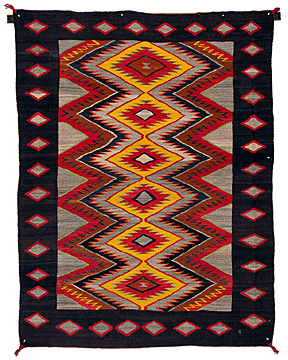 Navajo
weavings are many things to many people. These soft, woven textiles are
evocative, timeless works of art that transcend time and space. Navajo
weavings have captured the imagination of collectors not only because of
their beauty but also because they accurately mirror the social and
economic history of the Navajo people. Navajo
weavings are many things to many people. These soft, woven textiles are
evocative, timeless works of art that transcend time and space. Navajo
weavings have captured the imagination of collectors not only because of
their beauty but also because they accurately mirror the social and
economic history of the Navajo people.
Anthropologists speculate the Navajos learned to weave from Pueblo
people by 1650. There’s little doubt that the Spanish had already
influenced Pueblo weaving through the substitution of wool for cotton,
the introduction of indigo dye, and simple stripe patterning by the time
they shared their weaving skills with Navajo people. Besides the manta,
a wider-than-long wearing blanket, Navajo weavers also made a tunic-like
dress, garters, hair ties, belts, men's shirts, breechcloths, and a
serape-style wearing blanket that was longer-than-wide and patterned in
brown, blue and white stripes and terraced lines.
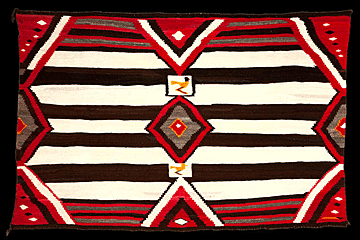 For
most of the 17th Century, the textiles produced by the Navajos were
almost identical to those of Pueblo weavers, but by the end of the 18th
Century, Navajo weavers began to go in different directions. While
Pueblo weavers continued to create traditional designs, Navajo weavers
learned they didn’t need to pass the weft through all the warps each
time, but rather, by stopping at whatever point they wished they could
create patterns other than horizontal bands. These pauses in Navajo
weaving, diagonal lines across the horizontal wefts, are often called
"lazy-lines." By the early 19th Century, Navajo weavers began using this
technique to create terraced lines and unique designs, as well as adding
color to their work. For
most of the 17th Century, the textiles produced by the Navajos were
almost identical to those of Pueblo weavers, but by the end of the 18th
Century, Navajo weavers began to go in different directions. While
Pueblo weavers continued to create traditional designs, Navajo weavers
learned they didn’t need to pass the weft through all the warps each
time, but rather, by stopping at whatever point they wished they could
create patterns other than horizontal bands. These pauses in Navajo
weaving, diagonal lines across the horizontal wefts, are often called
"lazy-lines." By the early 19th Century, Navajo weavers began using this
technique to create terraced lines and unique designs, as well as adding
color to their work.
In 1844, Josiah Gregg, while traveling along the Santa Fe Trail,
reported, "a singular species of blanket, known as the Serape Navajo
which is of so close and dense a texture that it will frequently hold
water almost equal to gum-elastic cloth. It is therefore highly prized
for protection against the rains. Some of the finer qualities are often
sold among the Mexicans as high as fifty or sixty dollars each."
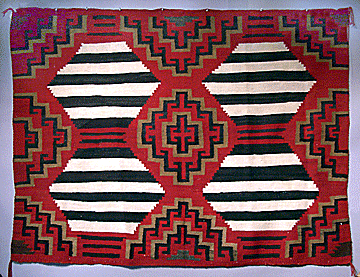 Unfortunately,
the Spanish and, later, the Mexicans had never been able to reach a
lasting peace with the Navajo. When Mexico ceded a portion of the
Southwest to the United States in 1848, the U.S. inherited the "Navajo
Problem." From 1863 to 1864, Kit Carson led a campaign against the
Navajos, destroying their food caches, herds and orchards. In the end,
over 8,000 Navajo people surrendered. He and his troops marched them
hundreds of miles to an arid, barren reservation, Bosque Redondo, at
Fort Sumner in eastern New Mexico. Unfortunately,
the Spanish and, later, the Mexicans had never been able to reach a
lasting peace with the Navajo. When Mexico ceded a portion of the
Southwest to the United States in 1848, the U.S. inherited the "Navajo
Problem." From 1863 to 1864, Kit Carson led a campaign against the
Navajos, destroying their food caches, herds and orchards. In the end,
over 8,000 Navajo people surrendered. He and his troops marched them
hundreds of miles to an arid, barren reservation, Bosque Redondo, at
Fort Sumner in eastern New Mexico.
The surrendered Navajos endured incarceration, with shortages of
supplies, food, and water, for five long years. Their culture changed
dramatically during this period. To substitute for their lost flocks,
the U.S. Government gave them cotton string, commercially-manufactured
natural- and aniline-dyed yarns as well as manufactured cloth and
blankets. In 1867, troops distributed 4,000 Spanish-made blankets to the
Navajos as part of their annuity payment. All of this lessened the need
to create their own textiles.
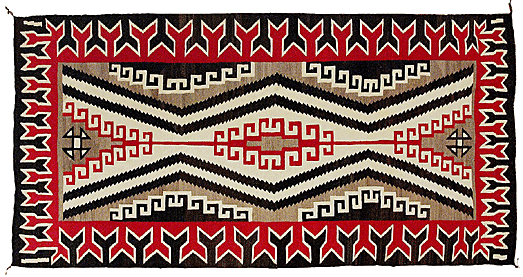
The combination of widespread availability of yarns and cloth and the
influence of the Spanish Saltillo designs inspired a dramatic shift in
Navajo weaving during the Bosque Redondo years. Weavers replaced the
striped and terraced patterns of the Classic period with the serrate or
diamond style of the Transitional period.
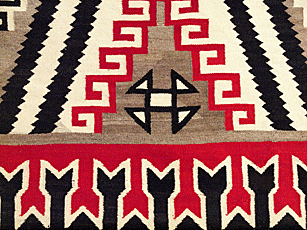 In
1868, the U.S. Government allowed the Navajo to return to their mesas
and canyons in what’s now northern Arizona. In exchange for their
return, they promised to cease aggressions against neighboring peoples
and to settle and become farmers. However, reservation life brought
further dramatic changes to Navajo culture, including a growing reliance
on American civilization and its products. Over the next 30 years,
selling their weavings provided a way for the Navajo to change from a
barter economy to a cash-based one. Since the Government goods included
yarns, wool cards, indigo dye, aniline dyes, and various kinds of
factory woven cloth, skirts and blouses made of this manufactured cloth
replaced the woven two-piece blanket dress. Manufactured Pendleton
blankets displaced hand-woven mantas and shoulder blankets so that by
the 1890s, there was little need for them to weave their own textiles. In
1868, the U.S. Government allowed the Navajo to return to their mesas
and canyons in what’s now northern Arizona. In exchange for their
return, they promised to cease aggressions against neighboring peoples
and to settle and become farmers. However, reservation life brought
further dramatic changes to Navajo culture, including a growing reliance
on American civilization and its products. Over the next 30 years,
selling their weavings provided a way for the Navajo to change from a
barter economy to a cash-based one. Since the Government goods included
yarns, wool cards, indigo dye, aniline dyes, and various kinds of
factory woven cloth, skirts and blouses made of this manufactured cloth
replaced the woven two-piece blanket dress. Manufactured Pendleton
blankets displaced hand-woven mantas and shoulder blankets so that by
the 1890s, there was little need for them to weave their own textiles.
Eventually, the U.S. Government licensed traders to establish posts on
the new Navajo Reservation. Whatever their motivation, adventure or
commerce, the traders became the chief link between the Navajo and the
non-Indian world.
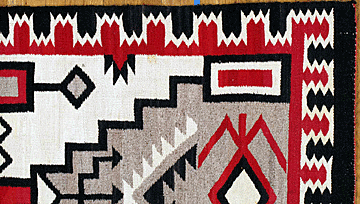 Trading
posts exchanged goods for Navajo products such as piñon nuts, wool,
sheep, jewelry, baskets, and rugs. Wool and sheep were important to the
Navajo for weaving and meat on their Reservation, as well as off. Mills
in the northeastern U.S. demanded wool for coats, upholstery, and other
products. Traders bought wool by the pound and sold it to wool brokers
in Albuquerque and Las Vegas, New Mexico. They purchased sheep and
herded them to the nearest railhead and on to the slaughterhouses. The
Navajo herds grew substantially, so it became more profitable for them
to sell wool rather than use it for weaving. Trading
posts exchanged goods for Navajo products such as piñon nuts, wool,
sheep, jewelry, baskets, and rugs. Wool and sheep were important to the
Navajo for weaving and meat on their Reservation, as well as off. Mills
in the northeastern U.S. demanded wool for coats, upholstery, and other
products. Traders bought wool by the pound and sold it to wool brokers
in Albuquerque and Las Vegas, New Mexico. They purchased sheep and
herded them to the nearest railhead and on to the slaughterhouses. The
Navajo herds grew substantially, so it became more profitable for them
to sell wool rather than use it for weaving.
By the 1880s, the railroad made travel to the West easier, thus opening
the area to tourists. The savvy traders recognized this new market and
began to pay higher prices for floor rugs and patterns using more muted
colors which they thought would be more attractive to non-lndian buyers.
Thus, the tourist trade infused new life into Navajo textiles. And by
1920, Navajo weaving developed around these trading posts, and rugs
produced for them took on the trading post’s name.
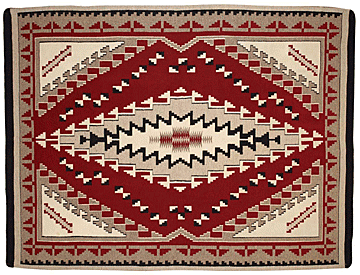 From
the looms of Navajo weavers came wool rugs comparable to the world’s
finest weavings. Each weaver built her own upright loom. Exposure to
larger markets had a significant effect on the evolution of this art
form, especially on the development of regional styles and patterns.
Although they are no longer accurate indicators of a Navajo rug’s
geographic origin, the regional names such as Wide Ruins, Two Grey
Hills, or Ganado still identify rugs of a particular style. These are
general styles, not specific patterns or designs. In Navajo weaving, the
weaver devises the patterns, so while two rugs may be very similar,
there are no two exactly alike. From
the looms of Navajo weavers came wool rugs comparable to the world’s
finest weavings. Each weaver built her own upright loom. Exposure to
larger markets had a significant effect on the evolution of this art
form, especially on the development of regional styles and patterns.
Although they are no longer accurate indicators of a Navajo rug’s
geographic origin, the regional names such as Wide Ruins, Two Grey
Hills, or Ganado still identify rugs of a particular style. These are
general styles, not specific patterns or designs. In Navajo weaving, the
weaver devises the patterns, so while two rugs may be very similar,
there are no two exactly alike.
Another more modern influence to Navajo weaving was the introduction of
electricity. As soon as electricity became available on the Navajo
reservation, life radically changed and so did the weavings. Radio,
television, telephone and magazines brought non-cultural related values,
issues and sense of place. Thus, Navajo weavings can be divided into two
categories: pre-electric and post-electric.
Navajo weaving has flourished throughout the 20th Century, maintaining
its importance as a vital native art. Weavers still weave virtually all
the 19th- and 20th-Century styles of blankets and rugs, and new styles
continue to appear.
To read
more of my articles, please
visit
my Web site.
<
Back to Collectibles Archives
Next Article > |
